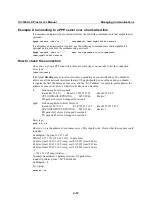
UC-7400-LX Plus User’s Manual
Managing Communications
4-2
Telnet / FTP
In addition to supporting Telnet client/server and FTP client/server, the UC-7400-LX Plus also
supports SSH and sftp client/server. To enable or disable the Telnet/ftp server, you first need to edit
the file
/etc/inetd.conf
.
Enabling the Telnet/ftp server
The following example shows the default content of the file
/etc/inetd.conf
. The default is to
enable the Telnet/ftp server:
discard dgram udp wait root /bin/discard
discard stream tcp nowait root /bin/discard
telnet stream tcp nowait root /bin/telnetd
ftp stream tcp nowait root /bin/ftpd -l
Disabling the Telnet/ftp server
Disable the daemon by typing ‘#’ in front of the first character of the row to comment out the line.
DNS
The UC-7400-LX Plus support DNS client (but not DNS server). To set up DNS client, you need
to edit three configuration files:
/etc/hosts
,
/etc/resolv.conf
, and
/etc/nsswitch.conf
.
/etc/hosts
is the first file that the Linux system reads to resolve the host name and IP address.
/etc/resolv.conf
is the most important file that you need to edit when using DNS for the other
programs. For example, before using
#ntpdate time.nist.goc
to update the system time, you will
need to add the DNS server address to the file. Ask your network administrator which DNS server
address you should use. The DNS server’s IP address is specified with the “nameserver” command.
For example, add the following line to
/etc/resolv.conf
if the DNS server’s IP address is
168.95.1.1:
nameserver 168.95.1.1
10.120.53.100 - PuTTY
root@Moxa:/etc# cat resolv.conf
#
# resolv.conf This file is the resolver configuration file
# See resolver(5).
#
#nameserver 192.168.1.16
nameserver 168.95.1.1
nameserver 140.115.1.31
nameserver 140.115.236.10
root@Moxa:/etc#
The file
/etc/nsswitch.conf
defines the sequence to resolve the IP address by using
/etc/hosts
file
or
/etc/resolv.conf
.
















































